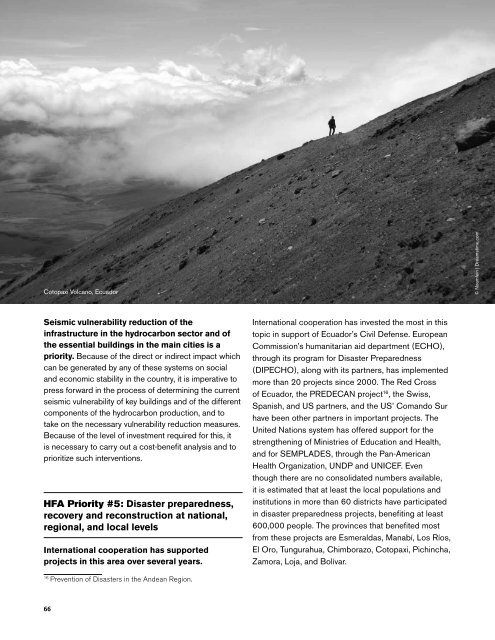Ecuador - GFDRR
Ecuador - GFDRR
Ecuador - GFDRR
Create successful ePaper yourself
Turn your PDF publications into a flip-book with our unique Google optimized e-Paper software.
Disaster Risk Management in Latin America and the Caribbean Region: <strong>GFDRR</strong> Country Notes<br />
Cotopaxi Volcano, <strong>Ecuador</strong><br />
© Noamfein | Dreamstime.com<br />
Seismic vulnerability reduction of the<br />
infrastructure in the hydrocarbon sector and of<br />
the essential buildings in the main cities is a<br />
priority. Because of the direct or indirect impact which<br />
can be generated by any of these systems on social<br />
and economic stability in the country, it is imperative to<br />
press forward in the process of determining the current<br />
seismic vulnerability of key buildings and of the different<br />
components of the hydrocarbon production, and to<br />
take on the necessary vulnerability reduction measures.<br />
Because of the level of investment required for this, it<br />
is necessary to carry out a cost-benefit analysis and to<br />
prioritize such interventions.<br />
HFA Priority #5: Disaster preparedness,<br />
recovery and reconstruction at national,<br />
regional, and local levels<br />
International cooperation has supported<br />
projects in this area over several years.<br />
International cooperation has invested the most in this<br />
topic in support of <strong>Ecuador</strong>’s Civil Defense. European<br />
Commission’s humanitarian aid department (ECHO),<br />
through its program for Disaster Preparedness<br />
(DIPECHO), along with its partners, has implemented<br />
more than 20 projects since 2000. The Red Cross<br />
of <strong>Ecuador</strong>, the PREDECAN project 16 , the Swiss,<br />
Spanish, and US partners, and the US’ Comando Sur<br />
have been other partners in important projects. The<br />
United Nations system has offered support for the<br />
strengthening of Ministries of Education and Health,<br />
and for SEMPLADES, through the Pan-American<br />
Health Organization, UNDP and UNICEF. Even<br />
though there are no consolidated numbers available,<br />
it is estimated that at least the local populations and<br />
institutions in more than 60 districts have participated<br />
in disaster preparedness projects, benefiting at least<br />
600,000 people. The provinces that benefited most<br />
from these projects are Esmeraldas, Manabí, Los Ríos,<br />
El Oro, Tungurahua, Chimborazo, Cotopaxi, Pichincha,<br />
Zamora, Loja, and Bolívar.<br />
16<br />
Prevention of Disasters in the Andean Region.<br />
66

















